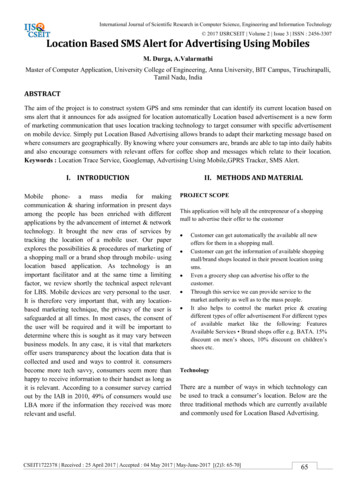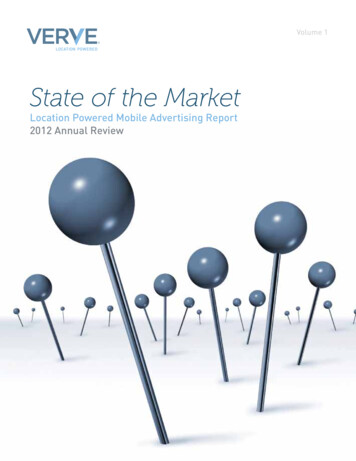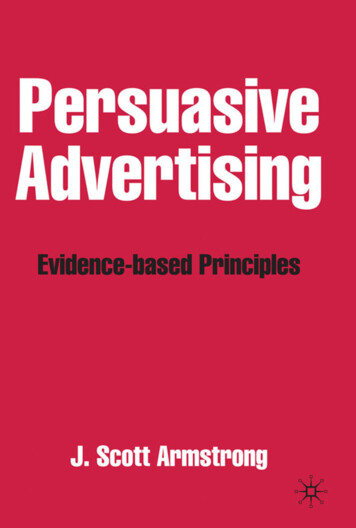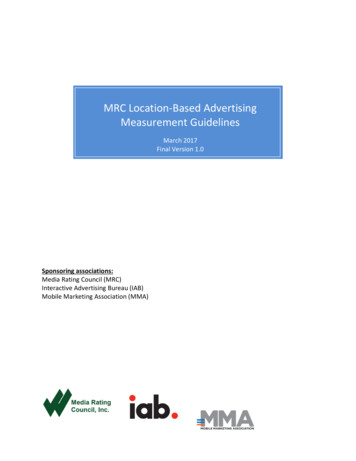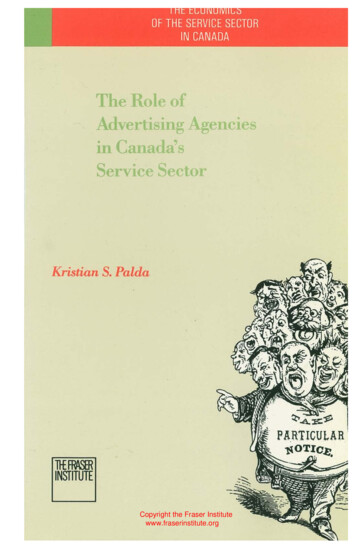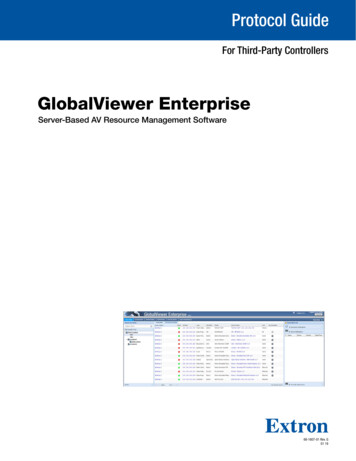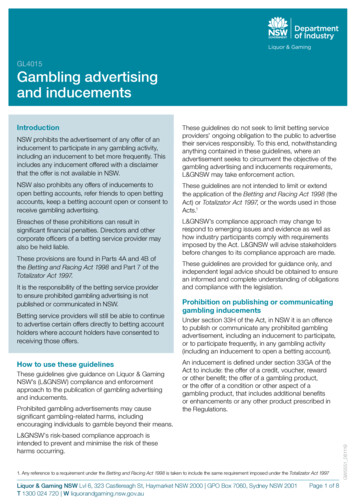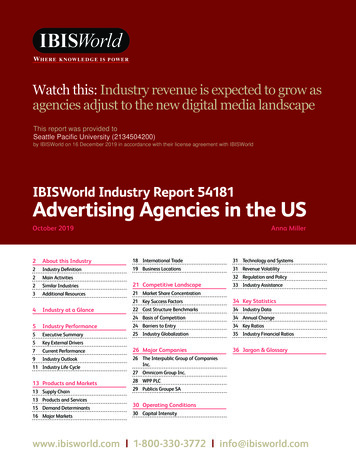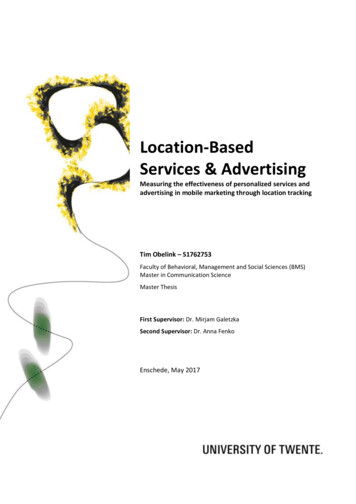
Transcription
Location-BasedServices & AdvertisingMeasuring the effectiveness of personalized services andadvertising in mobile marketing through location trackingTim Obelink – S1762753Faculty of Behavioral, Management and Social Sciences (BMS)Master in Communication ScienceMaster ThesisFirst Supervisor: Dr. Mirjam GaletzkaSecond Supervisor: Dr. Anna FenkoEnschede, May 2017
AbstractWith the widely-spread market penetration of mobile smartphones in the world as of 2017,the global marketing and communication industry’s interest in making use of thisdevelopment is rising. Despite the literature on mobile marketing and advertising and theincreasing number of organizations investing in this instrument, there is little academicresearch on the possibilities that the ‘mobile consumer world’ offers. Furthermore, theapplication of specific marketing methods through mobile phones are not yet fullyunderstood. This research aims at finding whether Location-Based Services can be successful ininforming consumers, using a mobile phone as the communication tool. The theoreticalbackground of these ‘Location-Based Services’ was tested through a survey, which mainlyfocusses on aspects regarding the intention to use mobile advertising. The practicalimplications of this tool were tested by executing a field experiment, in which multiple formsof Location-Based Services and Location-Based Advertising were tested in order to examinethe effects of these methods. This study found that the marketing method of Location-BasedServices could pose as an effective tool for organizations. Offering consumers real-timeinformation regarding products, discounts or events happening at their location, while theyare in a store, like LBS does, leads to positive results on factors like consumer attendance toa specific store area and the revenue of a featured product. By adding a price promotion tothis equation, its potential success could be enhanced further. Furthermore, this study foundthat consumers think of mobile communication and marketing as a useful added aspect ofan organization and that it contributes to a positive shopping experience. Despite thepositive results of this marketing tool, organizations should be cautious when implementingthis tool, taking into account the privacy risks and consumers’ perceived intrusiveness thatmight pose as a threat to the success.
Table of contents1Introduction42Theoretical Framework2.1Location-Based Services2.2Location-Based Advertising2.3Consumer Intention to use Mobile Marketing2.4Information Influence2.5Teaser influence2.6Coupon proneness2.7Consumer privacy concerns2.8Research Model - Study 12.9Location-Based Services Strategies2.10Research Model – Study 22.11Pre-test667810111111131417183Study 13.1Research Design and Material3.2Procedure and Participants3.3Measurement3.4Results of Study3.5Additional Analyses3.6Regression Analysis for Intention to use Mobile Marketing3.7Hypotheses Result Overview19191920222425264Study 24.1Testing Location-Based Services and Advertising4.2Conditions4.3Success Rate Measurements4.4Stimulus material4.5Procedure4.6Participants4.7Results of Study4.8Stimulus Material Results4.9Hypotheses Result Overview272728293031313232355Conclusion and Discussion5.1Conclusion5.2Practical Implications5.3Limitations and Future Research Directions5.4Overall Conclusion36363939396References40
1 IntroductionSince its introduction, the adoption and popularity of mobile marketing in corporate settingshas consistently grown. Mobile marketing is now able to implement Location-Based Services(LBS) and Location-Based Advertising (LBA). This new addition to mobile marketing uses thecurrent location of a device (through its GPS or Wi-Fi signal) in order to deliver locationspecific information to consumers.In March 2016, an article in Forbes (2016) reported that Location-Based marketing isfast becoming essential to organizations to remain competitive. People expect companies,especially large stores and multinationals, to engage in online and mobile marketing. Thisarticle goes as far as calling nowadays consumers a new generation of mobile dependentconsumers with very high demands of organization. Are organizations ready for this newform of marketing and are they willing to take the leap in order to benefit from its potentialsuccess?When technology development in the area online marketing was uprising, a ForresterResearch Report (Lussanet, Nordan, Koivu, Bedarida, & Roitman, 2001) reported on theworries companies expressed on committing to this new type of media marketing. In thisstudy, the fear of organizations thinking consumers would see this as an invasion of theirprivacy (80%) and the fear of a negative consumer reaction (60%) were considereddisadvantages of this new marketing method. This does not mean however that consumersfeel the same way regarding these disadvantages. The potential consumer concerns, fearedby organizations, were refuted by a comprehensive study concerning consumers experiencewith direct marketing channels such as mobile and online (Heinonen & Strandvik, 2006). Thestudy showed that 80% of respondents had an overall positive experience with thesemarketing channels. This does not mean however that privacy is not a concern forconsumers and no improvements should be made to increase the usability for bothmarketers and consumers.LBS provide the possibility to deliver highly personalized notifications to the liking ofevery individual consumer. Through mobile marketing the notifications a person receivescould be altered to consumer desires and therefore be perceived as less intrusive. This newmarketing method makes it possible for a consumer to select whether he/she wishes to receivea message with a sound notification or just a vibration when a notification is received. Theconsumers can alter these settings themselves by altering these aspects in their phone. Apartfrom this feature, mobile marketing can offer many more features based on consumer needs. Itcan for instance display product information when scanning a barcode, searching for a productcategory location in a large retail store or display the credit on a customer loyalty card (Singhal &Shukla, 2012), which in turn could be beneficial for organizations due to the increased (relevant)information deliverance to their consumers and new marketing possibilities.Mobile marketing can thus be implemented by organizations for several reasons. Itmakes it possible to provide service to consumers in or around a specific store, likeinforming them in relation to products or interesting places in the store and can overallcontribute to their shopping experience, known as the core of Location-Based Services.Another reason for implementing Location-Based Services is for marketing purposes. On theone hand, it can help organizations to increase sales and on the other hand it can provideconsumers with (financial) benefits. The marketing side of the LBS spectrum is often referred4
to as Location-Based Advertising. Location-Based Advertising could be beneficial toorganizations and was therefore part of this research study.This research aims at finding whether LBA can be successful in informing consumers, using amobile phone as the communication tool. Furthermore, the study aims at finding whether it hasthe potential to improve the overall shopping experience of consumers. Also, the effects ofadding a marketing component to this communication tool were examined. This was done inorder to assess whether this leads to an increase in response to stimulus material providedthrough LBS, a sales increase and the overall experience consumers perceive. A field experimentwas conducted to study the impact of LBA and LBS on consumer behavior measured by salesand attendance.This experiment consisted of a 2x2 experimental design. The four situations of theexperiment were: an informational stimulus (LBS), a price promotion stimulus (LBA), a premiumpromotion stimulus (LBA) and a combination of the price and premium promotion stimulus(LBA). These conditions were based on literature and the pre-test that was performed in thisresearch. These stimulus situations were all be compared to a baseline measurement, in orderto measure their effects and success. The baseline measurement consisted of past year’s (2016)figures in sales both in turnover amount and the amount of receipts.The main research question of the experiment in this research study was: Can LBS andLBA be effective communication/marketing tools for organizations?To assess the overall opinion that consumers have regarding to mobile marketing andLocation-Based Services/Advertising, a survey was conducted in this research study as well. Thissurvey aimed at reporting consumers’ opinion in regard to this new communication/marketingtool. The survey included measures based on the found literature, which are: Intentions to useMobile Advertising, Attitude Towards Mobile Marketing, Information Influence,Irritation/Intrusiveness, Personalization Benefits, Locatability Benefits, Risk Beliefs, PrivacyConcerns and Coupon Proneness. The main research question for the survey in this researchstudy was: Do consumers feel mobile marketing (including LBS and LBA) is a positive additionto their shopping experience or do they see it as a risky and privacy invading marketing tool?5
2 Theoretical FrameworkThe implementation of Location-Based Services/Advertising within organizations is still in anearly stage. Therefore, there is a shortage of empirical literature on this topic. The currenttheoretical framework aims at examining the known effects of LBS and LBA and wishes topredict the effects of the experiment and survey performed in this research. This was doneby consulting studies on (mobile) marketing and aspects of LBS/LBA like coupons and otherforms of direct advertising.In this theoretical framework, the service aspect of LBS has been described first (2.1)followed by the marketing aspect Location-Based Advertising (2.2) as a third chapter thestrategies in Location-Based Services (2.3) are being discussed, followed by the subject ofinformation sensitivity that has been explained (2.4) finally, the moderating variables thatcould influence this marketing method are shortly discussed.2.1 Location-Based ServicesMobile phones are quickly becoming one of the most used electronic devices in consumers’everyday lives. People nowadays seem to be unable to live without this gadget. It is the waypeople stay connected and it is seen as an extension of the self for many people (Butt &Phillips, 2008; Wilska, 2003). The upcoming and extensive use of this technology offers someunique and great opportunities for marketers. It offers the possibility to reach any person,anywhere, at any time. It offers the potential to organizations to connect with andcommunicate to consumers at times when the information is most relevant.Massive integration of mobile phone usage by consumers provides organizations with thebenefits and abilities of personalizing and timing content much more effective than before.The most common way of tracking people through their mobile phone is by GPS (GlobalPositioning System), which the vast majority of mobile phones is equipped with. This serviceoffers many possibilities to consumers like finding hotspots, navigation or receivinginformation on routing by public transportation. On the other hand, it could also be used formarketing and offering service to consumers by organizations.Location-Based Services can be described as a service that integrates the use of thespecific location of a mobile device to provide consumers with marketing (or purely service)information to add value to the consumers’ experience with the corresponding product,brand or organization of the supplier of the LBS (C. Bauer & Strauss, 2016). The goal of thesereal-time information is to expose consumers to personalized (marketing) content when it ismost relevant for them and they were most likely to see this form of promotion (Oliver,Rust, & Varki, 1998). Location-Based Services can be divided in two main pathways: theservice route and the advertising route (Location-Based Advertising).Thanks to the widely-spread use of smartphones which have several differentmechanisms to track people like GPS, Wi-Fi, mobile internet, Bluetooth, etc. tracking peoplehas become easier and more relevant for marketing purposes. A study executed byMarketingfacts (2015) in the Netherlands found that 81 percent of the Dutch populationbetween the age of 18 and 80 years old uses a smartphone on a daily basis. Earlier literaturestated the role of distance in social and economic behavior (Tobler, 1970). It stated that “allthings are related, yet near things are more related than far things”, forming a solidadvantage for mobile marketing as it is a way of near communication/marketing. The world6
of online marketing people live in thanks to the invention of the internet forms a revolutionthat already took away part of the distance barrier. Nowadays, it is much easier fororganizations to communicate to consumers on a large and on an individual scale throughthe internet. It has also become much easier for consumers to communicate toorganizations, that could be on the other side of the world, this way. Popular press releasesfrequently emphasized the internet’s ability to bring the “Death of Distance” (Cairncross,1997) or a “Flat World” (Friedman, 2005). Mobile marketing and LBS are viewed as the nextstep in this developing marketing environment thanks to its ability to deliver more relevantadvertising based on the targeted individual’s location. A study on LBS by Persuad and Azhar(2012) found that (as for traditional marketing) the shopping style, brand trust and value arekey motivations for engaging in mobile marketing. They also suggest a further study on howto engage customers with mobile marketing and real-life situations to see what works andwhat does not.The literature on Location-Based Services has expanded over the past years, due to theincreased usability of this marketing method. Over the past years a few empirical studies onthis topic have been published which describe the field and offer insights in the success andpossibilities of this marketing tool. The first real information on this topic started coming inthe early 2000’s describing this ‘new’ phenomenon and seeing the benefits it could bringwhen it could be implemented by companies to reach consumers on a large scale (Rao &Minakakis, 2003; Ververidis & Polyzos, 2002). Over the last 5-7 years’ smartphone adoptionhas taken a major leap as well as the literature and studies on this topic. The possibilities andbenefits of this marketing method are becoming more clear and successful real-lifeimplementation of this technology is now a (marketing) possibility for organizations (Dhar &Varshney, 2011; Shankar, Venkatesh, Hofacker, & Naik, 2010).Overall this development in the field of marketing means the distance between acompany’s marketing and the receiving consumers decreases. It is easier to target the (right)consumers, communicate to them at the right time in a relevant place and on a morepersonalized level than was possible before with more traditional marketing methods. Theseadvantages form the main reason LBA is such an interesting marketing method and haspotential to be a successful marketing tool (Junglas & Watson, 2008; Phillips et al., 2010;Schiller & Voisard, 2004). The advertising methods that are closely related to Location-BasedServices are the use of location marketing. For instance, placing billboards close to a shopwith directions on how to arrive there, to present two examples of this: ‘turn right in 200mfor our Garden Store’ or employees handing out flyers in a busy shopping street offering10% discount to a nearby clothing store. This is also a way of location advertising although itis not as selective as LBS, it is more intrusive and does not provide the flexibility this newway of mobile marketing offers, or can offer to any person at any given time when is rightand relevant for them (Scharl, Dickinger, & Murphy, 2005; Shankar et al., 2010).2.2 Location-Based AdvertisingLocation-Based Services can be used with an advertising purpose. In this chapter, a focus onLocation-Based Advertising was applied and the function of this new type of medium isexplained. Location-Based Services are a new way for organizations to reach their targetgroup, it offers many advantages to traditional marketing and can serve as a great tool forcommunicating with consumers and offering personalized marketing offers (Persaud &Azhar, 2012). The benefits that LBS can offer to consumers are mostly convenience. It is fast7
and relevant to their location and therefore also likely to meet their needs at that time andplace (Carroll, Barnes, & Scornavacca, 2005). It does not require any action from consumersthemselves apart from maybe downloading an app or configuring their phone. The additionof an advertising aspect to Location-Based Services could lead to further improvements ofthe benefits consumers experience while being confronted with this form of mobileservices/marketing. Advertising by confronting the consumers with a beneficial offer like aprice discount or free gift could improve their experience with LBS and also increase thechance of success (Gotlieb & Sarel, 1991; Lavidge & Steiner, 1961).Location-Based Advertising works differently from Location-Based Services. LBA couldbe used as an addition to LBS, in order to further improve LBS and (for organizationalbenefit) increase the sales of consumers visiting a certain area or store. The most commonlyused types of advertising promotions are price promotions and premium promotions (a freegift) according to literature (Palazon & Delgado‐Ballester, 2009; Yi & Yoo, 2011). The dangerlies in the intrusiveness and annoyance of Location-Based Advertising (Monk, Carroll, Parker,& Blythe, 2004). While the organizations may see it as a relevant service, the consumermight think of it as unwanted or intrusive and can even experience a feeling of theorganization invading on their privacy or personal space (Watson, McCarthy, & Rowley,2013). This type of “forced exposure” could cause psychological reactance in consumers thatis unwanted (Edwards, Li, & Lee, 2002). The way LBA is most used, is by making use of a popup on consumer’ mobile phone when they enter a certain geographical location. Forinstance, when a consumer is in a shopping district walking by a coffee shop, a pop-upappears reading a message: ‘come get a coffee at Starbucks and receive the second cup onthe house’. The consumer receives this LBS content via a vibrating/sound notification ontheir phone. The next step in this process is for the consumer to decide whether to act onthis offer. A consumer must be open to this and be willing to share their personalinformation in return for an offer based on their location that could be of added value tothem. This is considered as a crucial factor to the potential success of mobile marketing(Scharl et al., 2005).2.3 Consumer Intention to use Mobile MarketingMobile marketing contains many factors that also play a role in traditional marketing. Sincethe phenomenon of mobile marketing, especially with location-based possibilities, is fairlynew, the literature on it is scarce. Due to this fact, the factors that influence overallmarketing methods have been researched as well to see what their influence is on LBS andmobile marketing. The most important factor that organizations wish to know in this time iswhether the consumers have the intention to use mobile marketing.According to Bauer, Reichard and Barnes (2005) the intention to use mobile advertisingis influenced by multiple factors. First off, the overall attitude towards mobile advertisingplays an important role. Furthermore, the perceived relevance of the information thatmobile advertising can provide is important. Lastly, they describe the importance ofminimizing risk beliefs and privacy concerns in consumers.Consumers’ attitude towards mobile marketing is the first factor that could influencethe intention to use mobile marketing. Bauer, et al. (2005) describe this as is one of themajor factors in predicting the intention to use mobile marketing. According to them peoplewith a positive attitude towards mobile marketing display information seeking-behavior andare more likely to also have the intention to use mobile services/marketing.8
The second factor often mentioned in literature on mobile marketing is InformationInfluence (Altuna & Konuk, 2009; Tsang, Ho, & Liang, 2004). The information that a mobileapplication delivers to a consumer, and its perceived Information Influence by the user is afactor that can influence the opinion and attitude towards mobile marketing and itsapplications. This construct has many previous applications to assess the overall opiniontowards mobile marketing at their respective times in the field of marketing research. Forexample, the construct of information influence is supported in multiple studies like the twostudies mentioned before of Altuna & Konuk (2009) and Tsang, et al (2004).The benefits that are specific to mobile marketing and LBS have also been described inliterature. Two of the most important benefits of LBS/LBA compared to traditional marketingare the personalization benefits and the locatability benefits. Mobile marketing createspossibilities to further personalize messages to consumers and provide them with relevantinformation at the right time. There are many studies on the effect of relevant informationon sales that state that these factors are related and relevant information has a positiveinfluence on sales (Chen, Wu, & Yoon, 2004; Gurbaxani & Whang, 1991; Nelson, 1974).The locatability benefits by a phone through GPS amplifies this by knowing where theconsumer is and when he/she would like to receive his personalized message. Researchstates that personalization (Chellappa & Sin, 2005; Mittal & Lassar, 1996) and locatability(Xu, Teo, Tan, & Agarwal, 2009) could be significant influencers of the attitude towardsmobile marketing and LBS.As with every marketing method there are threats that could possible negativelyinfluence consumers’ intentions to make use of mobile services and marketing. One of thesefactors is the risk beliefs that live in consumers (Malhotra, Kim, & Agarwal, 2004b) aconstruct to measure this is was created by Jarvenpaa, Tractinsky & Saarinen (1999), thisconstruct is shown in appendence C of this research. A second factor that could negativelyaffect a consumer’s intention to use LBS/LBA is their privacy concerns. How safe do peoplefeel using mobile marketing regarding the privacy of their information? To accuratelymeasure this a few studies have researched the relation between mobile marketing andprivacy concerns (Chellappa & Sin, 2005; Sheng, Nah, & Siau, 2008), a deeper analysis on theliterature of this topic is presented later in this paper. The final factor that is seen as apotential negative influencer of the consumers’ intentions to use LBS/LBA is theirritation/Intrusiveness (Altuna & Konuk, 2009; Tsang et al., 2004) LBS/LBA could cause.Survey H1: The higher the attitude towards mobile advertising, the higher intention to usemobile marketing.Survey H2: The Information Influence consumers perceive contributes positively towards theintention to use mobile marketing.Survey H3: The perceived irritation/intrusiveness contributes negatively towards theintention to use mobile marketing.Survey H4: The perceived benefits contribute positively to the intention to use mobilemarketing.Survey H5: The risk beliefs contribute negatively towards the intention to use mobilemarketing.9
2.4 Information InfluenceOrganizations tend to gather a massive amount of information regarding their customersand target audience. At this time of internet shopping this is valuable information especiallywhen the link between the online and offline consumer can be made. Many companies goby a strategy of “Data Power”. Most of the online monitoring of people’s shoppingbehavior by organizations goes unnoticed by consumers. The premises of LBS and LBA arebased on personalized advertising that use consumer’s current geographical location. Inorder to be able to deliver this service, the consumer has to agree on sharing thisinformation with the organization. In order to take the next step in LBS it is crucial theconsumer is willing to provide his/her location in order to receive the benefits of LBS andLBA. Only then will the organization be able to combine this data with consumer preferencesand personalized accurate marketing information (Unni & Harmon, 2007).Researchers Phelps, Nowak & Ferrell (2000) examined the potential relationshipbetween categories of personal information, beliefs regarding direct marketing, situationalcharacteristics, specific privacy concerns and consumer’s direct marketing shopping habits.They also assessed a trade-off principle on which level consumers are willing to exchangepersonal information for shopping benefits. They found that in order for the consumer toshare personal information he/she must (feel like he/she) has some form of control on whathe/she shares. LBS is seen as a self-regulatory way of controlling the gathering ofinformation, because consumers have control over what they do and what they do notshare. Subsequently the organization must consider the type of information that is sought,because consumer concern and willingness to provide information to marketers withpersonal data vary dramatically by information type. Consumers’ main concerns are thoughtto revolve around sharing personal data like names, addresses, demographic characteristicsand purchase histories. Therefore, the reason for asking this information has to be clear.Phelps, Nowak & Ferrell (2000) distinguish five types of personal information that aremost commonly requested by organizations. These are: demographic data, lifestyleinterests, media habits, personal identification data (name, address phone number, etc.) andfinancial data (salary, bank account balance, etc.). The study results demonstrated thatconsumers are most willing to provide marketers with demographic and lifestyle informationand are least willing to provide financial information and personal identification data.Lastly, in a study on adoption of innovations (Rogers Everett, 1995) it was found thatadoption of an innovation was dependent on a person’s characteristics. For example, ahigher age correlated to lower scores on personal innovativeness. It also found that menscore higher on personal innovativeness and perceive findings as more positive than women.Women, on the other hand, look at findings in a more rational way. Also, female participantsof the study considered the risks and drawbacks more than men. This study therefore leadsto believe that men have a higher intention to use mobile marketing than women. Finally,people with higher education evaluate findings more than others and for the innovation ofLBS can lead to significant benefits and positively influence the shopping experience it isbelieved that higher educated people experience higher perceived benefits of thistechnology.10
2.5 Teaser influenceIt is important to provide a teaser. An informational service aims strictly at informing peopleof an event or interesting detail in a store, the addition of a teaser to this service like a priceor premium promotion could increase consumers’ response to this form of message. A studyon SMS (Chou & Lien, 2014) advertising demonstrated that a teaser increased productcuriosity especially in well-known brands. For consumers who were favorable to receivingSMS advertising a spokesperson could reduce or increase interest for less familiar brands,the addition of a spokesperson did not influence people with less favorable attitudestowards SMS. All in all, studies found that a teaser could be beneficial when used in the rightform on the right type of consumers. An even more positive effect could be reached if themessage was relevant and triggered familiarity with the brand or product (Chou & Lien,2014; Deighton & Grayson, 1995; Peng & Spencer, 2006).2.6 Coupon pronenessConsumers respond in different ways to receiving coupons. An example of this is oftendisplayed in busy shopping streets where consumers are confronted flyers being handedout. People that fall into the category of ‘value seekers’ are people who are activelysearching for promotions and feel a sense of accomplishment if money was saved or a freegift was received (Dickinger & Kleijnen, 2008). This category of consumers who are prone tocoupons might also be more open towards LBS and LBA and see it as more beneficial. On theother hand, the study by Dickinger and Kleijnen (2008) also illustrated that consumers thatare more open to receiving coupons also have a fear of spam and could possibly experiencea lack of control in receiving offerings like LBS advertising. So, in fact this is a double-edgedsword for these people; they search and collect coupons and are prone to advertisingmessages, yet their value proneness may be undermined by their fear of spam and theirfeelings of lack of control over receiving these messages. Overall the value of acoupon/promotion is determined by the perceived value and the perceived benefits of thatpromotion (Bawa, Srinivasan, & Srivastava, 1997; Lichtenstein, Netemeyer, & Burton, 1990).2.7 Consumer privacy concernsAmong marketers the trend of personal marketing is becoming increasingly popular as it is aproven method to influence consumers and increase sales (among others). However, more andmore consumers show uncertainty regarding their privacy as a result of these personalizedmethods. Wilson (2012) describes this phenomenon and calls it the ‘location-aware future’. Inthe ‘location-aware future’ consumers are constantly aware of their location an
to as Location-Based Advertising. Location-Based Advertising could be beneficial to organizations and was therefore part of this research study. This research aims at finding whether LBA can be successful in informing consumers, using a mobile phone as the communication tool. Furthermore, the study aims at finding whether it has
